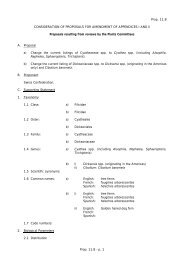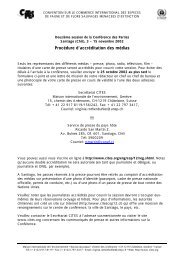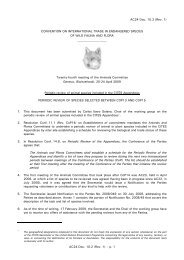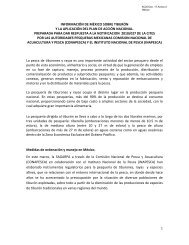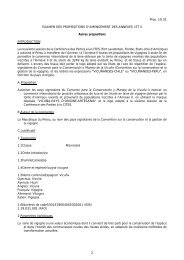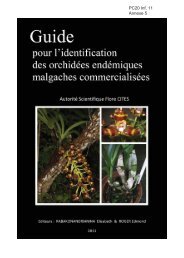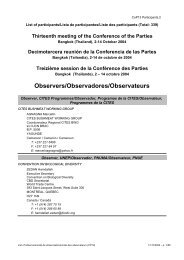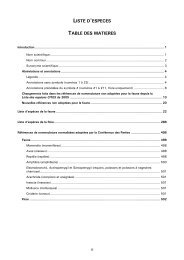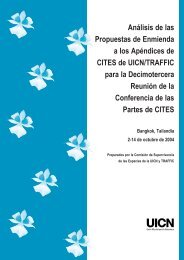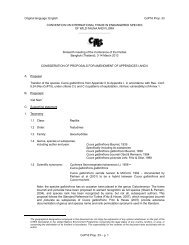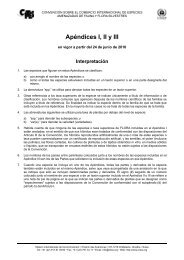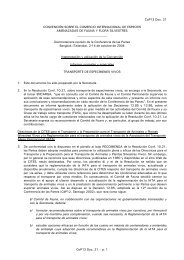Lamna nasus - Cites
Lamna nasus - Cites
Lamna nasus - Cites
Create successful ePaper yourself
Turn your PDF publications into a flip-book with our unique Google optimized e-Paper software.
Draft Proposal to list <strong>Lamna</strong> <strong>nasus</strong> in Appendix II - prepared by Germany in January 2012<br />
on the implementation of the Code of Conduct for Responsible Fisheries had Shark Plans in place and 11<br />
RFBs reported that they were assisting in the implementation of the IPOA-Sharks. Porbeagle range and/or<br />
fishing States with Shark Plans include Argentina, Australia, Canada, the EU, Japan, New Zealand, Spain,<br />
Taiwan, Uruguay and USA.<br />
Many RFMOs have adopted shark finning bans. Some RFOs have recently adopted shark resolutions to<br />
support improved recording or management of pelagic sharks taken as bycatch in the fisheries they manage,<br />
but no science-based catch limits. ICCAT has required Parties since 2007 to reduce the mortality of porbeagle<br />
sharks in directed Atlantic fisheries where a peer-reviewed stock assessment is not available. In 2008 the<br />
NAFO Scientific Council was warned that overfishing in the high seas NAFO Regulatory Area was<br />
undermining Canada’s management for porbeagles and would lead to population crash (Campana and Gibson<br />
2008), but Parties decided that shark management was ICCAT’s remit. Although a stock assessment has been<br />
available since 2009, neither ICCAT nor NAFO have adopted proposals to introduce catch limits or prohibit<br />
the retention of porbeagles caught on the high seas. At the time of writing, ICCAT’s Ecological Risk<br />
Assessment for pelagic sharks is in preparation for discussion at an ICCAT meeting on 11-15 th June 2012 in<br />
Portugal. The management of southern porbeagle stocks will require close coordination between RFMOs for<br />
the Atlantic, Pacific and Indian Ocean waters and CCAMLR.<br />
In the Northeast Atlantic, the conservation and management of sharks in EU waters falls under the European<br />
Common Fishery Policy (CFP), which manages fish stocks through a system of Total Allowable Catch (TAC<br />
or annual catch quotas) and reduction of fishing capacity. EC Regulation 40/2008 established a TAC for<br />
porbeagle taken in EC and international waters of I, II, III, IV, V, VI, VII, VIII, IX, X, XII and XIV of 581 t<br />
(CEC, 2008). The initial restrictive quota was reduced by 25% in 2009 and a maximum landing size (210 cm<br />
fork length) introduced to protect large females (CEC 2009). In 2010, EC Regulation 23/2010 prohibited<br />
fishing for porbeagle in EU waters and, for EU vessels, to fish for, to retain on board, to tranship and to land<br />
porbeagle in international waters. EC Regulation 1185/2003 prohibits the removal of shark fins and<br />
subsequent discarding of the body. This regulation is binding on EC vessels in all waters and non-EC vessels<br />
in Community waters.<br />
The European Community Action Plan for the Conservation and Management of Sharks (CPOA,<br />
EU COM(2009) 40 final), presented by the European Commission in 2009, sets out to rebuild depleted shark<br />
stocks fished by the Community fleet within and outside Community Waters, including through the<br />
establishment of catch limits for shark stocks in conformity with advice provided by ICES and relevant<br />
RFMOs, release of live unwanted bycatch, increased selectivity of fishing gear, establishment of bycatch<br />
reduction programmes for Critically Endangered and Endangered shark species, and international cooperation<br />
in CMS and CITES with a view to controlling shark fishing and trading. The CPOA’s Shark Assessment<br />
Report pays particular attention to <strong>Lamna</strong> <strong>nasus</strong>. These measures will be implemented at Community and<br />
Member State level and the Community will seek their endorsement by all relevant RFMOs.<br />
In 2007 Norway adopted ICES advice and banned all direct fisheries for porbeagle. From 2007–2011<br />
specimens taken as bycatch had to be landed and sold. From 2011, live specimens must be released, whereas<br />
dead specimens can (not must) be landed and sold. Reporting was extended to include the number of<br />
specimens landed in addition to weight. From 2011, the regulations also include recreational fishing.<br />
In the Northwest Atlantic, shark fisheries management is underway in Canadian and US waters. An annual<br />
quota of 92t was adopted in US waters in 1999, under the Highly Migratory Species Fisheries Management<br />
Plan. This was reduced in 2008 to a TAC of 11t for all US fisheries, including a commercial quota of 1.7t,<br />
which often lead to the closure of the fishery before the end of the year. Since 2008, US Atlantic sharks must<br />
be landed with their fins naturally attached. The 1995 Canadian fisheries management plan limits number of<br />
licenses, types of gear, fishing areas and seasons, prohibits finning, and restricts recreational fishing to catchand-release<br />
only. Fisheries management plans for pelagic sharks in Atlantic Canada established nonrestrictive<br />
catch guidelines of 1500t for L. <strong>nasus</strong> prior to 1997, followed by a provisional TAC of 1000t for<br />
the period 1997–1999, based largely on historic reported landings and the observation that recent catch rates<br />
had decreased (DFO 2001). Following analytical stock assessments (Campana et al. 1999, 2001), the Shark<br />
Management Plan for 2002–2007 reduced the TAC to 250t, followed by a further reduction to 185t (60t<br />
bycatch, 125t directed fishery) from 2006 (Figure 20). Population projections indicate that the population will<br />
eventually recover if harvest rates are kept under 4% (~185 mt, DFO 2005b), but unregulated and unreported<br />
catches on the high seas jeopardize recovery (Campana and Gibson 2008, Figures 14 and 15).<br />
In 2006, the Commission for the Conservation of Antarctic Marine Living Resources (CCAMLR) adopted a<br />
moratorium on directed shark fishing until data become available to assess the impacts of fishing on sharks in<br />
the Antarctic region. The live release of sharks taken as bycatch is encouraged but not mandated<br />
Page 12 of 14<br />
AC26 Doc. 26.2, Annex 1 – p. 12<br />
AC26 Doc. 26.2<br />
Annex / Anexo /Annexe<br />
(English only / únicamente en inglés / seulement en anglais)




